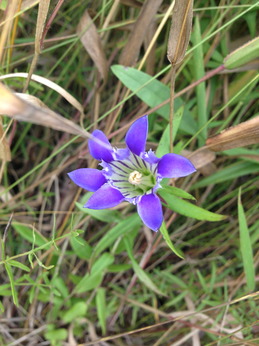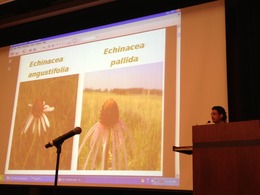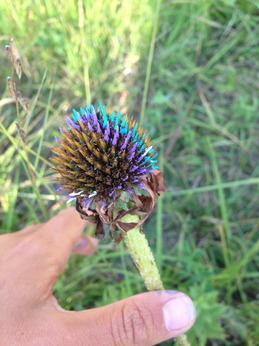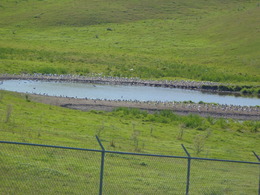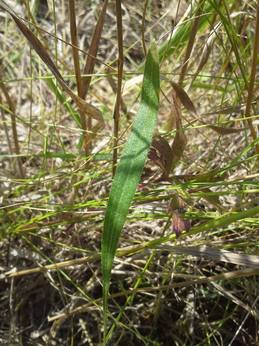|
|
The end of another week has snuck up on us. Kory left today which means Team Echinacea is down to just Ilse and myself. We’ll be around until early to mid-October or until all the field work is done for the season. Can you believe we’ll still have a couple heads flowering on Labor Day?!
Today we harvested for the second time in CG1. The three of us didn’t expect many heads to be ready, especially since 3 days ago we harvested ~1% of the flowering heads this year (and like I just mentioned, there are still heads flowering!) but holy moly! There was a sharp increase in the heads harvested today. I would estimate we got roughly 110 heads, which would put us around 6% complete. Maybe “holy moly” was a bit dramatic, but it seemed like a lot more than earlier this week. Many of these heads were also in the qGen2 crossing experiment which is great since we’ll want to get those heads drying and dissected as soon as possible in order to plant the achenes this fall (and before it snows).
We also continued surveying and entering demography information this week. Today Ilse, Kory, and I headed to the Landfill site where we flagged all the flowering plants and took information on how many heads they have and their GPS coordinates. We’ll still need Stuart to look over that site to make sure we have found all the flowering plants (try as we might, we seem to always miss a couple) but it’s been great to make some progress with the bigger sites.
This past week we also decided things might be a bit more interesting here in Douglas county if we renamed some of the remnants to be more exciting and/or secretive. Thus far we’ve come up with:
— Treasure Islandfill (and therefore Around Treasure Islandfill, North West of Treasure Islandfill, etc)
— King’s crossing (formerly railroad crossing)
— Loeffler’s Hollow
— Staffanson Prairie Plunder
— Lost Liatris Hill
Let us know if you think of any others. Be creative! We’ll want next year’s Team Echinacea curious and intrigued by the possible mysteries at each of the remnants.
Andddd speaking of Liatris, Ilse and I found a beautiful white Liatris at Hegg Lake while we were harvesting Dayvis’ E. pallida and E. angustifolia plants. Check it out!

Hopefully this week was the last of the heat wave! I’m ready for it to go back to being in the 70s. Have a good weekend!
Lydia
Hey Everyone! Here is my final conglomerated data (mine, Andrew’s and Katie’s). As well as my excel file with all the extra information. I will also be posting it in my dropbox as well.
Kory Kolis Final Data.csv
Poll_Efficiancy_Data Kory Kolis 2013.xlsx
What is a typical radiation dose experienced by an Echinacea seed when we x-ray Echinacea fruits to assess seed set?
We usually put the seeds on the bottom tray and the setting 10 s @ 18 kV. According to the documentation on dosage for our x-ray machine 18 kV outputs 292.6 R/h when the dosimeter probe is 57.2 cm away (that's the shelf with 1:1 magnification). The dose unit quote here R is Roetngen.
A little arithmetic can tell us total Roentgens for a ten second exposure:
( 10 s frac{1 h}{60 min} frac{1 min}{60 s} 292.6 frac{R}{h} )
In R code, that's
10 * 1/60 * 1/60 * 292.6
## [1] 0.8128
0.8128 R (Roentgen)
We may put the seeds on a higher shelf for more magnification, maybe 1:1.5 or the 1:2. We can enter dosages from each shelf from the documenation on exposure levels by shelf to estimate how much higher the dose is.
lvl <- c(1, 1.5, 2, 3, 4, 5)
RPM <- c(7.815, 20.55, 42.55, 115.45, 232, 397)
data.frame(shelf = lvl, dose = RPM)
## shelf dose
## 1 1.0 7.815
## 2 1.5 20.550
## 3 2.0 42.550
## 4 3.0 115.450
## 5 4.0 232.000
## 6 5.0 397.000
The dose on the 2x magnification shelf is RPM[3]/RPM[1] = 5.4447 times greater than the dose on the 1:1 shelf. Doubling the magnification generally should increase the dose by a factor of 5.4. Let's check: the dose on the 4x shelf is RPM[5]/RPM[3] = 5.4524 times greater than the dose on the 2x shelf. Also, the dose on the 3x shelf is RPM[4]/RPM[2] = 5.618 times greater than the dose on the 1.5x shelf. Close.
The expected dose at the stadard settings is 0.82 R on the bottom shelf and 0.8128 * 5.5 = 4.4704, or about 4.5 R on the 2x shelf.
Today was a very productive day! In the morning Ilse did phenology, and came back with great news! There are only seven heads left; flowering is almost done! Lydia worked on her aphid experiment and I worked on my poster. Around 10 am Ilse and I went to SPP and worked on the Demography project.
In the afternoon Lydia (one again) worked on her aphid project, and Ilse and I payed a visit to Hegg lake to do Demography on the recruitment sights. Overall a very productive day for Team Echinacea.
On a side note, this little blue gem just started flowering!

Kelly’s data from 2012 modified for use in RStudio
master_datasheet_MODIFIED.csv
After leaving June first to the Societyy of Wetland Scientists conference at Duluth, MN, I am definitely returning to the coolest city in this country “My sweet home Chicago” today. It has been a very interesting and special summer for me. I have had tons of good experiences. I certainly had the best experiences in the Star of the North (Minnesota). Specifically, with the Echinacea Project. Thanks guys of the Echinacea team 2013, Gretel, Stuart, and family.
On August 26th, Marie and me had the opportunity of sharing our respective research in the Field Museum of Chicago. We found a very receptive audience for the Echinacea project. I had good amount of very interesting questions. Overall, people liked the fact that several students have been working in research that complement each other. This is the case of Shona in 2012 with Marie and me in 2013.
Now, I am preparing to present this research again in my university symposium on September 20th and as a poster presentation at the SACNAS National conference at San Antonio TX next on October 4th.
Again, Thank you very much to everybody who is or has been part of this fascinating enterprise called the Echinacea project

We wrapped up the week with a productive Friday. In the morning Kory headed out to Hegg Lake, while Sarah assessed phenology in the common garden (I think we were down to 75 heads today). Ilse and I have been slowly repainting the heads in the qGen2 crossing experiment. Nothing is ready to be harvested from the experiment yet, but it’s good to revisit the plants and stay ahead of any paint flaking off. Even without painting the entire head (a mistake I was making earlier this week) it’s still a slow process. Here’s one I finished today. I still may be going a little excessive with the paint…

Before lunch we all weeded the common garden for any leftover thistle and birdsfoot trefoil. We managed to pull quite a bit of thistle but didn’t find any trefoil. A good sign? After a quick lunch we split up and went to the remnants Steven’s approach and Riley to finish up the last three seedling searches. We all went our separate ways after that: Ilse continued to re-paint heads, Kory edited the last of his pollinator videos, and I finally finished my “re-checks” in the common garden (I seem to be the slow poke of the group). I also began taking pictures of leaves in the aphid addition/exclusion experiment to count trichomes and see if there are any differences between treatments. I’ll keep everyone posted as that progresses.
Have a good weekend!
Today was a busy day for the four of us. We started work at 8am searching for “can’t finds” in the common garden. Kory and Ilse left after about an hour to GPS Landfill for seedling re-finds. Lydia and I followed soon after. We finished Landfill around 11 and then flagged flowering plants we came across. These will be mapped later on.
Gulls always seem to love hanging around Landfill and they can often be seen huge flocks around the site.

Kory and I went and flagged re-find points at East of Town Hall. Then we met Ilse and Lydia back at the Hjelm house for lunch.
The afternoon consisted of Kory and Ilse going to do seedling re-finds at Randt while Lydia and I did re-finds at East of Town Hall. We finally finished all the seedling re-finds!!!
We also continued our searches in the common garden.
Can you spot the plant I found at a “can’t find” position?

That’s all for today!
– Sarah B
Flowering phenology data from summer 2013. This version contains data collected from 7 July, 2013 to 26 August, 2013. PhenDataMASTERcsv_28-Aug-2013.csv
It’s getting lonelier and lonelier at the Hjelm house these days. Today is was just Lydia, Sarah, Kory, and I. The morning consisted of phenology and seedling refinds at SPP. Then after lunch Lydia worked on her aphid addition/exclusion experiment and it seems that the aphids are disliking this heat wave almost as much as us, if not more, as she found an abundance of aphid skeletons this afternoon. I pollentated and repainted some heads while Kory and Sarah knocked off a few rows each of refinds in the cg1. Then the three of us hit up LC and found some seedlings. Here is a seedling from 09, as you probably could have surmised yourself.
The afternoon wrapped up with the most pressing of tasks…some unfinished business if you may. We began the process of finishing up some ice cream that has been in the freezer all summer. Hopefully it wont take too long to finish off the rest of the ice cream, but I’m sure we will manage somehow, working long hours if we must.
|
|

-thumb-260x346-136589.jpg)
